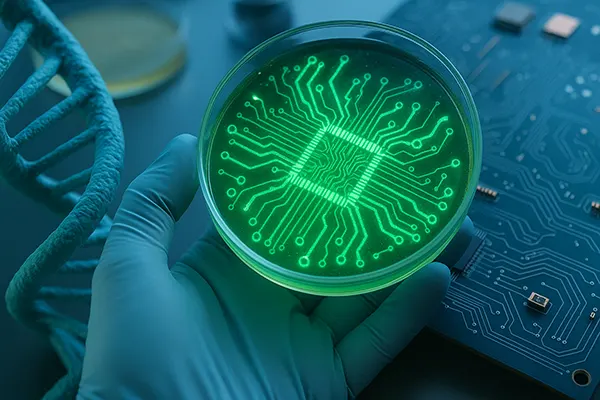
Synthetic Biology and ‘Living Computers’: New Frontiers in Biocomputing
Synthetic biology has become a driving force of 21st-century innovation, where engineered biological systems are being designed to perform computational tasks. In recent years, the field has rapidly evolved from basic gene editing to complex biocircuits capable of processing information like digital hardware. As of February 2025, the integration of biocomputing and synthetic organisms has reached unprecedented milestones. These “living computers” are not science fiction—they are programmable, scalable, and increasingly relevant for medicine, environmental science, and data processing.
Engineering Life to Process Data
Scientists have now harnessed cells to execute logic functions, comparable to those in classical computing. Using CRISPR and DNA-based logic gates, synthetic biologists can instruct a cell to perform IF/THEN logical operations, store memory, and even respond dynamically to environmental stimuli. This functionality is encoded directly into the DNA, enabling precise decision-making at the cellular level.
In 2024, researchers at the University of Washington developed programmable bacteria that act as biosensors in contaminated water. These living machines not only detect pollutants but calculate their concentrations and communicate results via fluorescence—biological computation with practical environmental application.
Another significant breakthrough is the implementation of Boolean circuits within yeast cells. These circuits can be reconfigured on demand, representing a shift toward modular, biological processors capable of being updated like firmware. The implications stretch beyond research labs into agriculture, diagnostics, and smart therapeutics.
Limitations and Control Mechanisms
Despite the promise, living computers face inherent limitations. Biological materials degrade, replicate unpredictably, and are sensitive to noise. To combat these challenges, developers implement genetic “kill-switches” and error-correction logic, ensuring system stability and preventing biohazard risks.
Control systems now employ layered feedback loops that mimic redundancy and fail-safes found in aerospace technology. These loops allow the biological system to self-regulate and recalibrate operations if environmental conditions shift unexpectedly, enhancing reliability and safety.
Standardisation is another frontier. Projects like the Synthetic Biology Open Language (SBOL) have established protocols for designing, sharing, and validating biological circuits, ensuring consistent results across laboratories and organisations globally. These frameworks are crucial as synthetic life systems scale into industrial settings.
Applications Beyond Traditional Computing
Living computers differ fundamentally from silicon machines—they operate in moist environments, are self-replicating, and can be interfaced directly with the human body. These features open doors to biomedical applications previously out of reach for digital technologies.
One striking example is the use of engineered immune cells to diagnose and treat cancer. CAR-T cell therapies are now equipped with programmable biosensors that identify specific tumour antigens and launch tailored responses, adjusting dynamically as the cancer evolves.
In 2025, a European biotech consortium unveiled a prototype of a gut-embedded micro-organism that calculates insulin needs in diabetic patients in real time. These biocomputing organisms measure blood sugar fluctuations and release insulin-mimicking molecules only when necessary—ushering in personalised, internalised medicine.
Environmental and Industrial Integration
The marriage of synthetic biology and computation also has transformative effects on industry. Bioreactors embedded with smart microbial networks can now manage production variables, such as pH and temperature, autonomously. This level of internal computation improves yields and reduces costs in biofuel and pharmaceutical production.
Another innovation involves biodegradable sensors that decompose harmlessly after performing their computational tasks in soil or water. These devices support precision farming, tracking nutrient cycles and sending data to cloud systems before breaking down naturally.
In wastewater treatment, biocomputers can be deployed to monitor pathogens, balance chemical levels, and optimise energy usage. This operational intelligence makes systems more adaptive, sustainable, and economically efficient.

Ethical, Regulatory, and Future Perspectives
As living computers become more autonomous, ethical questions emerge. What rights do we assign to synthetic organisms with decision-making capabilities? How do we ensure transparency and accountability in systems that evolve post-deployment?
Current regulatory frameworks lag behind these innovations. Most jurisdictions classify programmable microbes as GMOs, yet their capabilities far exceed traditional modified organisms. In 2025, new policy drafts in the EU and US seek to redefine “digital biology” and enforce biosafety standards specific to programmable lifeforms.
Looking ahead, biocomputing may not replace silicon-based processors but instead coexist and complement them. Hybrid devices combining silicon logic with living substrates are under development, promising bio-electronic interfaces that leverage the strengths of both domains.
Public Awareness and Scientific Collaboration
Public understanding remains limited. Awareness campaigns are critical to demystify synthetic biology and encourage informed discourse. Educational initiatives in secondary schools and open-access online courses aim to close the knowledge gap in 2025 and beyond.
Global collaboration is also essential. Shared databases, cross-border research initiatives, and ethical councils are key to navigating the biocomputing frontier responsibly. Projects like BioBricks Foundation and SynBioBeta are examples of efforts to unite scientists, entrepreneurs, and policymakers around transparent development.
Ultimately, synthetic biology and living computers redefine what it means to compute, offering sustainable, integrative, and radically new tools for a future that is already beginning to take shape in our cells.
